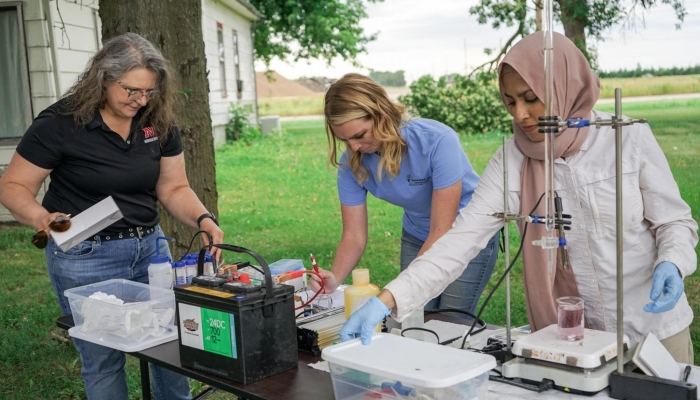New study explores common water quality impairments linked to negative birth outcomes in Nebraska
Expectant parents are often concerned about health and safety as they plan for the arrival of their little one: what’s the crash test rating of this car seat? Is this infant swing linked to SIDS? Which formula is the highest quality?
New research from the University of Nebraska Medical Center and University of Nebraska – Lincoln with the help of local NRDs explores one additional safety factor would-be parents in Nebraska must consider: is the water they are drinking during pregnancy safe?
This latest study shows that in areas of Nebraska where birth defect prevalence is high, water contamination from common agricultural chemicals (nitrate and atrazine) are also high. The study shows that water quality concerns in Nebraska are closely tied to both birth defects and miscarriage.
The Background
According to the study’s authors, birth defects annually affect approximately three percent of all babies born in the United States. In Nebraska, the number is substantially higher. Between 2011 and 2015, about six percent of all babies born in Nebraska (24,965) had at least one birth defect. Some of these infants had multiple birth defects, so the total number of birth defects reported for that period was 45,134. Causes for birth defects are complicated and most involve multiple factors, including genetic, behavioral, and environmental conditions.
Exposure to some anthropogenic (human caused) environmental toxins has been linked to birth defects, including atrazine and nitrate, which are widely used in agriculture for pest control and fertilizer, respectively. With agriculture extensively practiced in Nebraska, these agrichemicals are used intensively in row crop agriculture across the state. Both nitrate and atrazine are found in local waterways and groundwater across much of Nebraska. Additionally, these human-introduced contaminants can lead to the mobilization of naturally occurring elements, resulting in further contamination of drinking water sources. For example, elevated concentrations of nitrate have been correlated with the mobilization of naturally occurring uranium in the High Plains Aquifer (study link). Moderate to high arsenic concentrations have been found in Nebraska as well. Other studies have shown that uranium and arsenic are also potential risk factors for birth defects.
The Study
The recent study from UNMC took a unique approach to studying the connection between these various toxins in water and birth defects in the state. First, the researchers looked at all live births reported in Nebraska during a 20-year period and mapped the locations of prevalence of birth defects. The study further focused in on watersheds (the drainage area around a river) with at least 100 live births in the 20-year period. They organized the study around watershed areas rather than traditional geographic boundaries such as county lines or zip codes, as they were looking at water quality metrics specifically. The study considered two areas of the state with above average rates of reported birth defects at the watershed level within the Lower Elkhorn and Upper Big Blue Natural Resources Districts. Researchers from the university and NRD staff collected and tested water samples from domestic wells in 2021 and 2022 in those watersheds and tracked concentrations of nitrate, atrazine, uranium, and arsenic. Parental behavioral data including tobacco use, diabetes, and maternal age were also compared in the study.
For the sake of the study, it was assumed that current water contaminant levels were similar to levels consumed by the expectant parents in the 20-year period studied. The assumption is supported by data that shows agricultural activities and practices have been steady or increasing for many decades in Nebraska.
The Findings
More than 80 percent of Nebraska watersheds have birth defect rates that are above the national average. There are a few ‘hotspots’ in the state where the rate is even higher. Study authors observed that several clusters of birth defect locations also have high average nitrate and/or atrazine levels. These levels are above the MCL, or the maximum contaminant level considered safe by the federal EPA. Since tests were not taken at the time of pregnancy, exact individual level exposure to nitrate and other contaminants was not measured for this study.
What this data shows is that in areas of Nebraska where these contaminants in groundwater are increased, there is a higher prevalence of birth defects.
Researchers found that nitrate and atrazine were detected across the included watersheds in varying amounts. Groundwater nitrate concentration ranged from very low (.56 mg/L) to extremely high (97.21 mg/L). For reference, the MCL for safe drinking water is 10 mg/L of nitrate. Groundwater atrazine concentrations ranged from 0.00 to 11.23 µg/L. The MCL for atrazine is 3 µg/L.
The findings of the current research corroborate many other studies that reported a positive association between relatively higher nitrate concentration in drinking water and the occurrence of birth defects. In fact, the study found that though the MCL for nitrate in drinking water set by the EPA is 10 mg/L, watersheds with nitrate concentration above 6.94 mg/L had higher prevalence of birth defects compared to the reference group. For atrazine, the study showed an increase in birth defects with any concentration above zero. When additional risk factors, including the presence of mobilized arsenic and uranium are included, higher nitrate concentration reduced the rate of birth defects potentially because it instead increased rates of miscarriage, the authors hypothesize. This is based on four previous studies that suggest an association between maternal exposure to these compounds in drinking water and the occurrence of spontaneous abortion.
This most recent study builds on previous research showing that women with a drinking water nitrate concentration about 10 mg/L (the EPA recommended maximum contamination level) had four times greater likelihood of a child with a birth defect than their counterparts whose water supplies had a nitrate concentration at or below 10 mg/L. More concerning, another study found a significant increase in the incidence of birth defects connected to expectant parents drinking water with nitrate levels of 1-5.56 mg/L (well below the MCL) compared to less than 1 mg/L after controlling for other variables and risk factors.
The current study suggests that chronic exposure to nitrate and atrazine, even at amounts below current standards, may result in birth defects. Additionally, exposure to uranium and arsenic mobilized in drinking water supplies by nitrates may increase the risk of pregnancy loss.
What now?
Domestic well users in Nebraska are responsible for maintaining the integrity of their own water supply. They should have it tested annually for contaminants—a process that residents of the Upper Big Blue NRD can do for free through its walk-in water testing program (which tests for nitrates and bacteria) and at-home test kits (which test for nitrate, nitrite, and phosphorus). However, this doesn’t go far enough, say UNMC study authors who recommend continuous monitoring of private well water by state agencies to ensure contaminants are at a safe level. Currently there is no regulatory agency tasked with performing such monitoring on domestic wells, as there is on municipal wells.
The researchers further recommend that domestic well users whose water tests above the maximum contaminant level for the elements mentioned in the study be provided with a home filtration system or an alternative water source. Currently, there is a small amount of funding available from the Nebraska Department of Environment and Energy for Nebraskans who have domestic wells that test beyond 10 mg/L for nitrate. The funding allows individuals to install reverse osmosis systems in their homes, but it is up to the individual to seek out this funding, install, and maintain the system. There is additional funding available through this program for municipalities in Nebraska to access large scale reverse osmosis solutions as well.
The final recommendation from the study is for Nebraska’s agricultural producers to improve their practices to reduce the prevalence of groundwater and surface water contamination. The Upper Big Blue NRD has several programs available to producers to assist in this goal, from funding for cover crops to irrigation improvement to buffer strips. The Upper Big Blue NRD invites all district producers to reach out to district staff today to get started improving their operation to more actively protect the purity of the water we all share.


